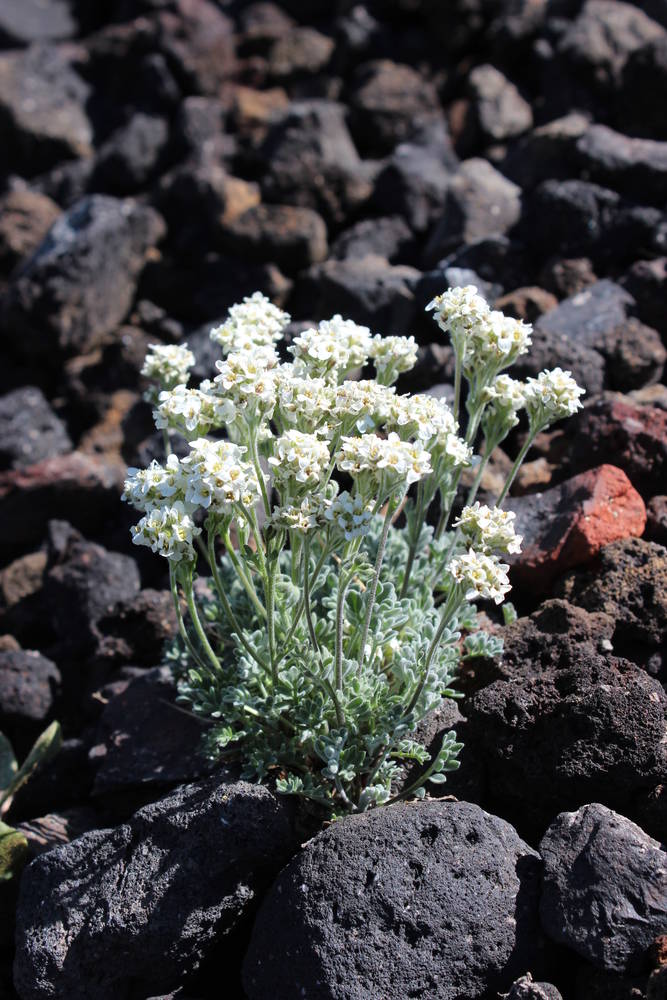
Plants cespitose, gray-pubescent with simple and smaller dendritic trichomes; caudices branched, covered with petioles of previous seasons.
Stems 3–18 cm.
Basal leaves blades 0.5–2.5 × 0.5–1.5 cm, pinnatisect or pinnatifid, ciliate with simple trichomes; ultimate segments obovate or oblong, 2–10 × 1.5–5 mm; petioles 1–6 cm.
Cauline leaves few, alternate, similar to basal but smaller; short-petiolate to sessile.
Inflorescences fruiting pedicels suberect to ascending, often forming < 40° angle, 3–10 mm; lowermost sometimes with bracts.
Flowers sepals persistent, ovate, 2–2.5 mm; petals spatulate to obovate, 3.5–4.5 × 1.5–2.5 mm, white or rarely pinkish, claws 0.5–1.5 mm; ovules 4–8 per ovary, styles 0.2–1 mm.
Fruits subappressed to rachis to ascending, ovoid, terete or slightly compressed, obtuse at both ends, 2–6 × 2–3 mm; valve midveins obscure.
Seeds 1–1.5 × 0.6–0.7 mm.
Loose talus, rocky moraines, rock crevices. Flowering Jul–Aug. 2000–3000 m. Casc. CA, WA; north to British Columbia. Native.
as described under Smelowskia ovalis
Plants sometimes canescent basally; caudex branched. Stems: several from base, unbranched or branched distally, 0.3-1.8 dm, trichomes simple, 0.3-0.6 mm, mixed with smaller, dendritic ones. Basal leaves: petiole 1-6 cm, ciliate, trichomes simple; blade obovate, ovate, suborbicular, or oblong in outline, (terminal segments obovate or oblong), 0.5-2.5 cm × 5-15 mm, (terminal segments 0.2-1 cm × 1.5-5 mm), margins pinnatisect or pinnatifid, apex obtuse or rounded. Cauline leaves shortly petiolate or sessile; blade similar to basal, smaller distally. Racemes elongated and dense in fruit. Fruiting pedicels suberect to ascending, (subappressed to rachis, often forming less than 40˚ angle), proximalmost sometimes bracteate, 3-10 mm, pubescent, trichomes simple (to 1 mm), mixed with smaller, dendritic ones. Flowers: sepals (persistent), 2-2.5 mm; petals usually white, rarely pinkish, spatulate to obovate, 3.5-4.5 × 1.5-2.5 mm, narrowed to claw, 0.5-1.5 mm, apex rounded; anthers oblong, 0.5-0.6 mm. Fruits suberect to ascending, ovoid to suboblong, terete or slightly flattened, 2-6 × 2-3 mm, base and apex obtuse; valves each with obscure midvein; ovules 4-8 per ovary; style 0.2-1 mm. Seeds 1-1.5 × 0.6-0.7 mm.Flowering Jul-Aug. Loose talus, mica shist, alpine rock slides, rocky moraines, rock crevices; 1500-3400 m; B.C.; Calif., Oreg., Wash.Smelowskia ovalis appears to be rare in Oregon, common at Mt. Lassen (Shasta County, California), and widespread at high elevations in Washington.